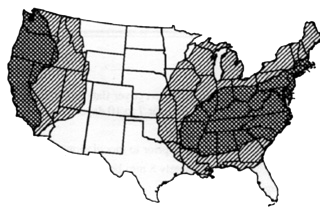Sclerotinia trifoliorum Eriks. PDF
L. H. Rhodes
Greenhouse ....Pots or flats
Container .....1 part soil:l part peat:l part vermiculite, limed (if necessary) to approximately pH 7
Temp/Light ....20 to 25°C; 12+ hours daylength
No. of Plants .... Approximately 1 week after emergence, thin seedlings to 25 per replication
No. of Reps ...4 replications
Other .........Fertilize with Hoagland's solution No. 2 I week after emergence, 50 mL per 25 seedlings
INOCULUM CULTURE
Source ........Axenic culture
Storage........Acidified potato dextrose agar cultures (1 mL 85% lactic acid per liter of PDA)
Temperature....4°C
Storage Life ..Up to 3 years
INOCULATION PROCEDURE
Age of Plant ..2 weeks
Type of Inoc...Mycelial fragment suspension
Inoc. Prod.......... Difco potato dextrose broth shake cultures: Inoculate sterile PD broth with 7 mm diameter agar plugs from margins of actively growing S. trifoliorum cultures; incubate for 7 days at 15°C on rotary shaker; blend 3 spherical colonies (each 28-30 mm in diameter) for 2-3 seconds only in 250 mL water in a Waring Blender; strain the inoculum through a 50 micron sieve; spray approximately 3 minutes per flat
Method ......... .... Foliar spray with mycelial fragment suspension, 50 mL per 150 plants (1 flat)
Location ......Growth chamber; cover flats wilh clear plastic domes for 7 to 10 days
Temp ..........15°C optimum
Plant counts ..Count plants prior to inoculation
Spacing .......Approximately 8 mm between plants
Age at rating .... 3 weeks
RATING
1 Resistant......... Healthy plant; no evidence of infection (or, only 1 or 2 small leaf lesions).
2 Resistant ......... Light damage; one upper trifoliolate may be affected
3 Mod. Susc.....Terminal, including top leaves, killed back, basal portion of stem, including some lower leaves, may still be green
4 Susceptible ..Plant still alive but severely damaged; most of top is rotted or discolored
5 Susceptible ..Dead plant
CHECK CULTIVARS
| Approximate Expected Resistance (%) | Acceptable Range of Reaction (%) | |
| Resistant | ||
| Vernal | 25 | 10-40 |
| Susceptible | ||
| Armor | 3 | 0-5 |
Values for resistant standards include total of l's and 2's.
SCLEROTINIA CROWN AND STEM ROT
RESISTANCE
Sclerotinia trifoliorum Eriks. (Click on the map above for a larger version. See also the KEY)
SOURCES OF INOCULUM
AND EXPERTISE
Name .....Landon H. Rhodes
Address ..Department of Plant Pathology
201 Kottman Hall, 2021 Coffey Raod
The Ohio State University
Columbus, OH 43210
Phone ............... (614) 292-1375
CORRELATION TO FIELD REACTION
Unknown.
RACES
No races of Sclerotinia trifoliorum have been reported. Differences in virulence may exist between isolates of S. trifoliorum.
INOCULATION OPTIONS AND RANGE OF CONDITIONS
Immediately prior to inoculation plants are misted with water (approximately 10 mL per 25 plants). Plants are then sprayed with a suspension of mycelial fragments prepared by blending 3 spherical colonies of S. trifoliorum in 250 mL water (50 mL inoculum per 150 plants).
Because seedling reaction is dependent on inoculum load, it is important to spray inoculum evenly over all entries. Also, because of near total decomposition of some plants, seedlings should be counted prior to inoculation. When plants are rated for disease severity, those which cannot be accounted for are assumed to be rotted and given a rating of 5.
ALTERNATIVE METHODS
Field evaluations may be conducted in areas of high infestation (2).
REFERENCES
1. Pierson, P.E., T.H. Anderson, and L.H. Rhodes. 1988. Screening for resistance to Sclerotinia trifoliorum in vivo and in vitro. Proc. 31st N Am. Alfalfa Imp. Conf.pp.15.
2. Rhodes, L.H., T.H. Anderson, P.E. Pierson, and D.K. Myers. 1989. Field evaluation of Sclerotinia crown and stem rot in six alfalfa cultivars. Proc. 21st Central Alfalfa Imp. Conf. pp.l3-14.
